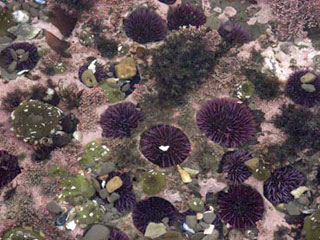The spines of the sea urchin are an engineering marvel. Each such thorn, from its base to its tip, is, in fact, one crystal. When they break, the sea urchin spines develop and repair themselves within a few days. A team of scientists from the Weizmann Institute of Science recently discovered how they do this.

Crystals - such as sugar and salt crystals - are formed from atoms or molecules dissolved in a liquid, and have characteristic, predetermined shapes. But Prof. Leah Eddy, Prof. Steve Weiner and members of their research groups in the Department of Structural Biology at the Weizmann Institute of Science, found that the sea urchin uses a different method to grow the crystals that make up its spines. At the beginning of the process, the material used to build the spikes is found in a non-crystalline configuration called amorphous calcium carbonate (ACC. Bundles of this material are pushed from the cells around the base of the spike to the fracture site, from where the spike will develop and complete itself. Within a few hours of the material's arrival at this point, The amorphous ACC is transformed into an organized calcite crystal that forms the regenerated spine, allowing the animal to control the crystal design.
To follow the deposition and formation process of the ACC, the scientists - including research student Yael Politi, Dr. Eugenia Klein and Talmon Arad from the Chemical Research Infrastructure Unit of the Weizmann Institute of Science - used four different research methods, including two types of electron microscopy. "It is natural to ask," says Prof. Weiner, "why it was so difficult for us to examine a process that seems to us to be extremely basic, which scientists have been studying for more than a century. But in fact, because the ACC configuration exists only temporarily, we were required to develop new ways and methods that allowed us to operate in the relatively narrow window of opportunity of the existence of the material in this configuration."
The photographs of the regenerated thorns show microscopic needles that initially grow straight from the stump of the broken thorn, then branch out to form a tough, but light, lace-like structure. The crystalline structure of the old thorn is a kind of template that dictates and controls the organization of the molecules of the new material, in the growing crystal.
In previous studies, the institute's scientists discovered that this method of operation is applied by molluscs and young sea urchins, which are in the larval stage, for the purpose of building their internal skeleton. But in the current study it became clear, for the first time, that adult marine animals also use this construction method. The lifestyle of a larva is very different from that of an adult (for example, the tiny larva of the sea urchin is transparent and swims, compared to the round and spiky adult that lives on the sea floor). It is therefore surprising to find that both use the same method of operation. This discovery led Prof. Addi and Prof. Weiner to hypothesize that this method is a basic strategy shared by a wide variety of creatures with spines and shells such as molluscs and corals.
The scientists say that the ability to grow single crystals from an amorphous material may be applied to the production and processing of advanced synthetic materials with the properties of single crystals.
